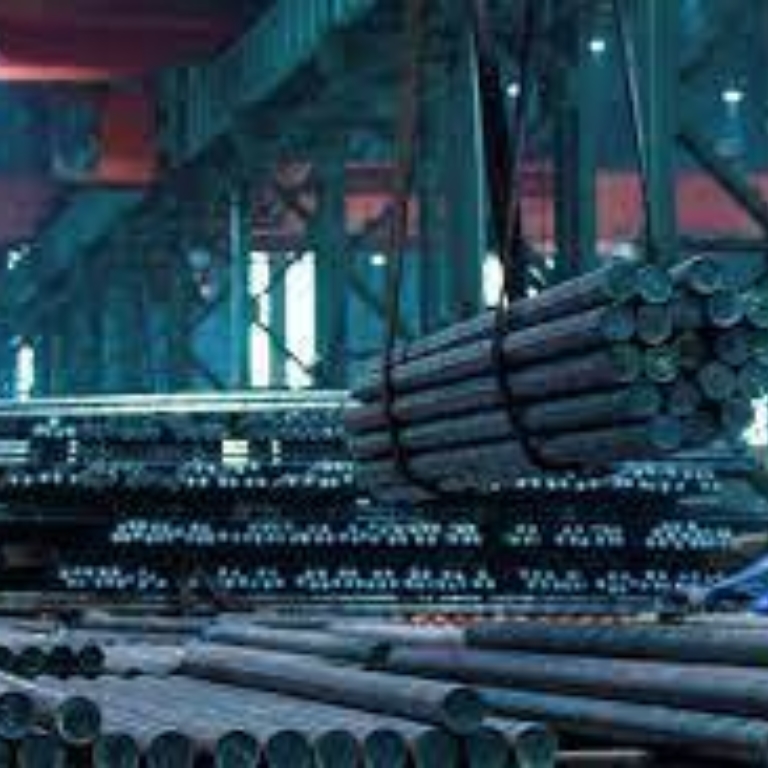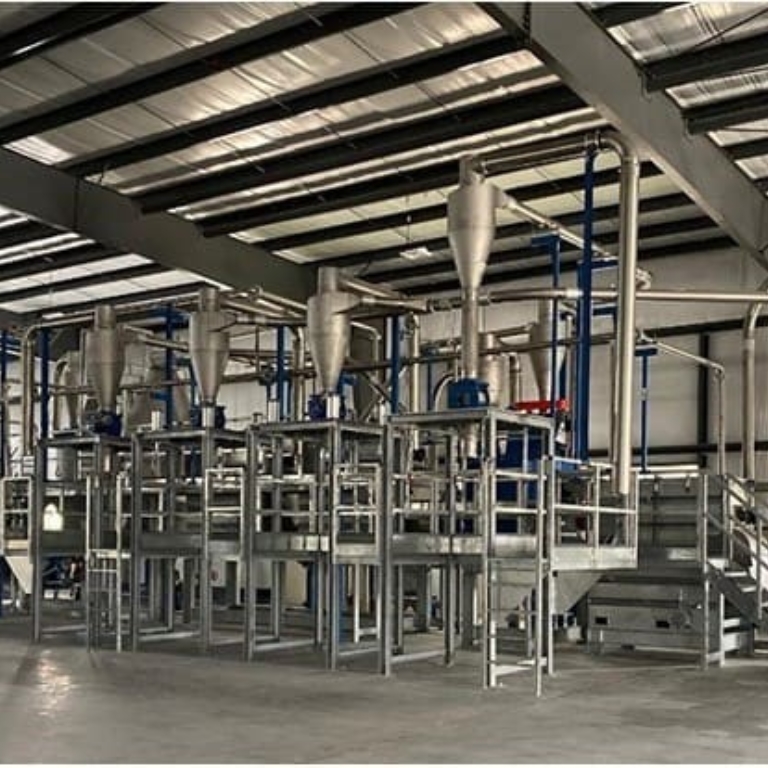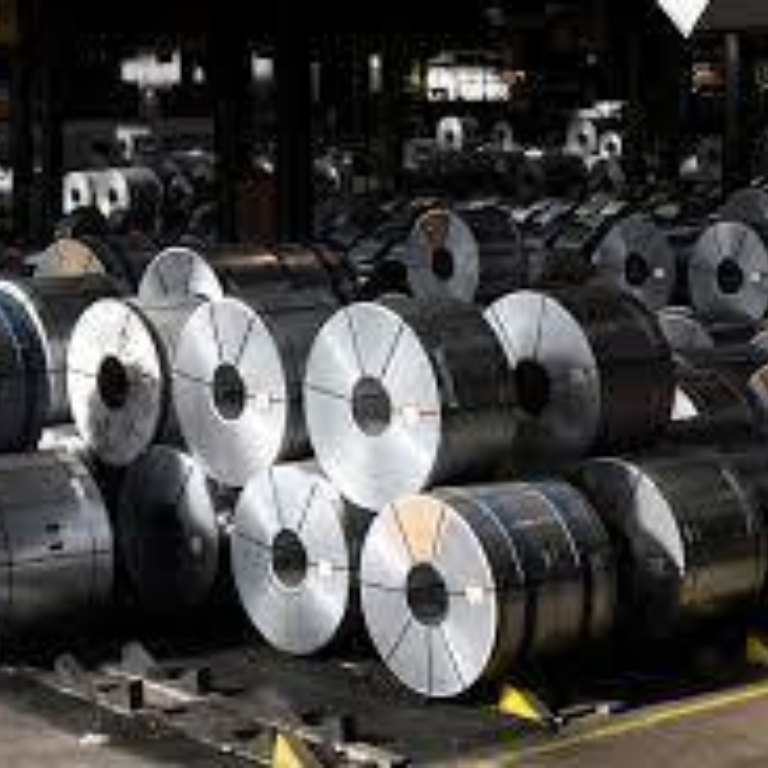5G Transformation Hub
How 5G MEC enables green steel
What positive change is being made, and how?
Masteel Harbour Raw Material Factory sits on the northwest of Maanshan City by the River Yangtze. One of China’s major steel industrial equipment plants, this waterfront production facility has placed 5G Industrial IoT (IIoT) at the core of its digital transformation strategy. By deploying 5G connectivity, and various related technologies it enables, Masteel has significantly improved business processes, decreased overheads and reduced its carbon footprint.
Select a project
Contents
Challenge
Manufacturing iron and steel equipment is a lengthy process, which, due to the complexity and variety of production methods, can often be stop- start, and therefore inefficient. In recent years, modernization initiatives have introduced various automated processes but this has often resulted in high maintenance costs and a knowledge-gap in finding personnel who are readily trained to operate such equipment. The recent increase in pressure to reduce emissions has further underscored the need to introduce digital transformation as a better means to achieve these combined goals.
Solution
By making use of 5G’s various capabilities such as enhanced mobile broadband, Masteel has introduced massive levels of connectivity across the plant – enabling previously unconnected equipment to provide new data and operate more efficiently. Importantly, 5G has made also it made possible to incorporate other transformational technologies such as AI, AR, and edge computing – all of which have been integrated integrated with Masteel’s existing industrial intranet. The combined solution has set the plant course of path of sustainable state-of-the-art digital transformation and achieved its goal of reduced costs and improved efficiency.
Impact & Statistics
The 19 standalone SA 5G points replaced 52 industrial Wi-Fi systems, which required 30% less investment and increased productivity by 20%. The initiative has translated into a manpower cut of 36 persons in the early stage and 200 persons in the later stage, saving CNY 8 million per year.
Wider Implications
The project has demonstrated to the wider industry that 5G networks can play a decisive role in eliminating pain-points that come along with existing Wi-Fi setups that necessitate wired optical cables, and demonstrates that 5G and the technologies it enables can be integrated into existing IT systems.
Stakeholders
Working with PHIMA Intelligence Technology, China Unicom and Huawei, Masteel jointly deployed and integrated 19 5G standalone (SA) 5G sites and a multi-edge computing (MEC) system to work in operation with Masteel’s existing industrial intranet.
02
How 5G MEC enables green steel
What positive change is being made, and how?
Each year the Harbour Raw Material Factory records an annual output of 10.1 million tons, and is considered a ‘granary’ of Masteel’s iron-making raw materials. The factory covers 1.15 million square metres, houses 6 blast furnaces, 5 sintering machines, 100 large mobile machines, cloth vehicles, and tripper cars – this equipment is connected via 427 belts totalling around 70 kilometres in length and observed by more than 1,000 video surveillance points. Despite this mass of equipment, the plant previously struggled with adjusting its production levels to meet the needs of national economy and reduce its emissions – both critical issues throughout iron and steel production. To address these core issues, Masteel’s transformation initiative was oriented around three key areas:
Data standard deficiency, isolation and stovepipe systems:
The data between factory equipment features is in incompatible systems leading to data silos, data fragmentation, and network diversification. With standalone systems and data, efficiency could be greatly reduced.
Hazardous operating environments and labour-intensive production processes:
Like many iron and steel plants, there are many on-site areas which carry inherent safety risks such as air quality and temperature – such areas must be made safer. Compounding this issue is the reliance the plant has on some jobs which are either hazardous or require excessive training to execute safely.
Wireless and fibreoptic network infrastructure:
Most of the on-site intranet use fibre optics and Wi-Fi connection. Neither technologies are suitable for mobile scenarios nor conducive to flexible manufacturing due to their suboptimal
reliability and costly maintenance. Moreover,
steel mills are dominated by the steel frame
structure, which can exacerbate serious
electromagnetic and multi-way interference
which would otherwise be abated by high-
reliability, stable and low-latency mobile
networks, which in themselves could also
enable the deployment of other emerging
technologies such as AI, AR, and edge
computing.

03
Undergoing transformation
By assessing these issues with PHIMA Intelligence Technology, China Unicom, and Huawei, Masteel embarked on their digital tran formation strategy, which involved the replacing 52 industrial Wi-Fi systems with 19 5G SA sites in the raw material factory and an MEC (UPF + MEP) system in Masteel’s data centre to enable in-depth integration new network with Masteel’s high-quality industrial intranet. This 5G infrastructure enabled Masteel to pilot solutions such as unmanned stacker-reclaimers, a 3D digital material factory, intelligent conveyor belt inspections, AI production behaviour supervision, intelligent video platforms and an intelligent AR operation and maintenance project.
3D MATERIAL AND INVENTORY MANAGEMENT
5G has had a huge impact on material and inventory management. For 5G has had a huge impact on material and inventory management. For example, the process of stacking and reclaiming positions, heights, lengths, and widths of the stockpiles which are now no-longer dependent on individual observations and personal judgment. By deploying 5G-enabled mobile 3D scanners, stockpiles can now be analysed in real time. Hitherto, the only option here was via wired optical fibres, which while physically impractical are also unsuitable for transferring the large amounts of data necessary to run an up-to-date and accurate cloud- based stock solution. With 5G, the massive amount of point cloud data scanned by 3D scanners is sent back to the data centre near-immediately, enabling real-time stocktaking and enhanced operational planning. Since implementation, the stockyards have increased production efficiency by 20%.
3D UNMANNED STACKERS AND RECLAIMERS
The stockyards, which are covered with protective sheds, are subject to serious vibrations from reclaimer motions, resulting in a harsh operating environment. Remote, unmanned driving of the stackers and reclaimers is required to improve the operating environment. Conventionally, fibre optics are used for remote transmission of video signals and control signals, with fibre reels placed on the rotating discs of the stackers and reclaimers to move, lay, and pick fibre optics. In this setup, optical fibres are prone to interruption which can affect normal production, complicate maintenance, and increase cost.
The introduction of 5G has enabled 3D modelling data, intelligent sensors, high-definition video technologies and real-time communication between control systems and the remote, intelligent decision-making systems which make use of low latency to enable inter-system coordination and unmanned operation of stackers and reclaimers. Typically this scenario requires precise control of production equipment and is demanding on the service latency (usually less than 20ms). However, the 5G access and MEC local offloading ensure the smooth operation of remote, unmanned driving. Combined with network slicing, the solution can meet the networking needs for remote, unmanned driving, realise flexible, independent sliced network resources, and guarantee network quality and safety of use.
INTELLIGENT CRUISING
The material factory has a total of 427 sealing-tape machines, which, due to their sheer number are complex to manage. In the event of any equipment faults, it becomes difficult to retrieve video footage of faulty equipment among so many recordings. Thankfully, 5G networks enable the transmission of high-definition videos. Based on the specific process chain information as well as the electrical fault and alarm messages of the equipment, operators can quickly locate the faulty points and automatically identify the monitoring camera of the equipment to project the image on to larger screens or send it to the terminal belonging to the relevant maintenance personnel. This 5G-enabled solution supports ‘video cruising’ and monitoring the specific production processes that following customizable routes.
By deploying application capabilities such as map sharing, route planning, and scheduling management, 5G solutions can enable remote cruise control and scheduling while sending back data such as real-time, high-definition images, equipment information, and environmental information over the 5G network. The edge cloud uses video transcoding and decoding and AI inference among other functions to pre-process video data and then transmits it to the central cloud. The central AI system conducts in-depth analysis of the collected data to identify any abnormality in the equipment or environment in the cruise area.
AI SUPERVISION OF PRODUCTION BEHAVIOUR
Managers may find it difficult to
constantly supervise and issue
reminders on the production
behaviours of personnel in scenarios
that feature a large area of operation,
scattered with various sites and
disciplines. However, enhanced disciplines. However, enhanced
mobile broadband enabled by 5G
supports transmission of 4K high-
definition videos of the operation sites
in real-time. Combined with the AI
platform, 5G supervision solutions can
help analyse production behaviours
intelligently and record and issue real-
time inefficiency and hazard alerts. This
can prevent accident, personal injury
and damage to equipment.
With the 5G network traffic to data businesses well managed, one or more recognition algorithms can be configured for video streams or video files as needed by using functional modules such as AI algorithm libraries of atomic capabilities and intelligent video analysis. The solution includes the automatically captured event photos, event descriptions and time of occurrence overall achieving intelligent supervision of production behaviour.
AR OPERATION AND MAINTENANCE
Previously, operation and maintenance personnel manually recorded equipment operation and maintenance details in the paper form or via electronic platforms. For complex equipment, it was necessary to invite experts to the site to offer guidance on a regular or temporary basis. However, this approach has always been beset by semantic difficulties.
This has been transformed by 5G-enabled AR glasses which are used to record the spot-check details - and provide analysis - of each component. In a complex industrial environment, experts provide real-time guidance through text, images, real-time annotations and other spatial annotations that enable real-time interactions from the point of view of those seeing things first-hand. With the ability to invite multiple participants to engage with the issue, the AR solution can quickly locate the issues and share solutions in real-time via cloud-based interactions and remote diagnosis.
Automatic deployment and transcoding, rendering, and splicing capabilities of AR applications lays the network foundation for 5G and AR intelligent operations and maintenance and remote collaboration, supporting AR annotations, multi-user high-definition audio and video communication, and document-sharing achieving technical support with dramatically reduced costs.
INTELLIGENT MAINTENANCE AND INSPECTION OF SEALING-TAPE MACHINES
Sealing-tape machines are a staple of the factory yet prone to motor or reducer failures, belt misalignments, slip, tearing, and other issues during production and operation due to the complex operating environment, the long transportation distance, and the large volume of material transported. What’s worse, the lack of effective detection and monitoring methods can lead to consequences such as lower production efficiency and severe accidents.
To address these issues, smart sensors have been used and 5G network technologies to improve the detection methods on equipment operational statuses, established a real-time digital model for equipment to manage equipment in a visualised manner,utilised an intelligent analysis model for rapid and intelligent diagnosis of faults, and conducted a systematic digital health assessment to ensure safe operation of the system.
In addition, Masteel has also analysed and evaluated equipment health statuses based on historical data and machine learning algorithms and models to implement predictive maintenance. Meanwhile, intelligent maintenance has been set up, with an inspection system which includes file management, spare part management, and equipment maintenance functions to remotely carry out operation, maintenance, and monitoring in an information-based and intelligent approach.
5G-based intelligent maintenance and inspection of sealing-tape machines is underpinned by collecting real-time data on motors, reducers and tapes. This data is then uploaded periodically and subject to algorithm-based analyses. The results are then sent to the operation and maintenance personnel to predict the equipment status and take measures in advance against any tape faults and safety risks.

04
The results of digital transformation: efficiency and output soar
The 5G pilot application in the raw material factory has demonstrated that 5G can eliminate many critical pain-points in ways which wired optical cables and Wi-Fi connections cannot. The organic convergence of the 5G private network and Masteel’s industrial intranets has connected company’s CT, OT, and IT systems, enabling reliable communication with less jitter, low latency, and far higher speeds. This ensures Masteel’s industrial production network remains competitive and has achieved remote, centralised, machine- powered, control and operation, machine-powered operation and maintenance.
The project has also set Masteel on its way to build a ‘5G + industrial internet’ industrial ecosystem which can be applied to the entire logistics and supply chain system. In collaboration with project partners, the deployment has also helped identify further enhancements in network planning and design, business modelling as well as more scenarios that can apply 5G such as video surveillance, remote control, and unmanned driving. The implementation of 5G has tackled the critical issues of steel production, poor operating environments, complex network deployment, excessive operators, low efficiency, high operation and maintenance costs, high labour intensity, difficult operations and maintenance evaluations, and limited supervisory measures. 5G’s integration with industrial applications has deepened relationships with ecosystem partners to inform new applications and accelerate 5G integration into R&D and design, production and manufacturing, fault operation and maintenance, logistics and transportation, and safety management.

05
Building on success and enhancing collaboration
The next step is to research and plan more value-creation scenarios through the portfolio of 5G-enabled technologies such AI, edge computing, cloud-computing. These could be used in coal blending, 5G data acquisition and predictive maintenance, the deployment of electronic fences and many other automated green operations.
The aim is then to incubate innovative solutions prior to commercial deployment. By gradually testing and launching advanced solutions, such as reliable core network schemes, the dual-transmit and selective-receive mode, and 5G LAN to ensure network connectivity even in case of Internet disconnection, operations can be improved even further.
Alongside this there is a plan to build an application- enabling platform that will be focused on automatic operation, maintenance, and management platform targeting networks, terminals, and businesses to achieve terminal device management, real-time business process monitoring, fault alarming, and positioning and boundary setting, for the purposes of further solidifying assets, accumulating capabilities, and accelerating business incubation and launch.
The final and perhaps most important next step is to scale within industry. By developing and improving standard 5G private network solutions and end-to-end products targeting iron and steel application scenarios, capabilities can be opened up elsewhere, promoting scaled replication and industrial upgrading of the capabilities within the Masteel Group and wider industry.

06
About
About the GSMA
The GSMA is a global organisation unifying the mobile ecosystem to discover, develop and deliver innovation foundational to positive business environments and societal change. Our vision is to unlock the full power of connectivity so that people,
industry, and society thrive. Representing mobile operators and organisations across the mobile ecosystem and adjacent industries, the GSMA delivers for its members across three broad pillars: Connectivity for Good, Industry Services and Solutions, and Outreach. This activity includes advancing policy, tackling today’s biggest societal challenges, underpinning the technology and interoperability that make mobile work, and providing the world’s largest platform to convene the mobile ecosystem at the MWC and M360 series of events.
For more information, please visit the GSMA corporate website at www.gsma.com.
Follow the GSMA on Twitter: @GSMA.
GSMA 5G Transformation Hub
The GSMA 5G Transformation Hub is a source of information on some of the most innovative 5G solutions in the world. This portal contains case studies detailing design, benefits, key players, measured value and the future impact of scaling up these 5G solutions worldwide. The 5G Era is now firmly established and this family of standardised GSM technologies, including mmWave, are being rolled out successfully across the globe. The GSMA 5G Transformation Hub, launched at MWC Barcelona in 2022, provides details of how 5G is best placed to deliver real value for a range of key sectors including manufacturing, energy, transportation, media and live entertainment, smart cities and construction.. Many more case studies will be added, in the coming months, covering even more industries and the GSMA is asking Members to nominate innovative 5G case studies to add to this global digital showcase. The 5G Transformation Hub and this particular Case Study are both sponsored by Qualcomm.
About this case study
This case study is for information only and is provided as is. The GSM Association makes no representations and gives no warranties or undertakings (express or implied) with respect to the study and does not accept any responsibility for , and hereby disclaims any liability for the accuracy or completeness or timeliness of the information contained in this document. Any use of the study is at the users own risk and the user assumes liability for any third party claims associated with such use.